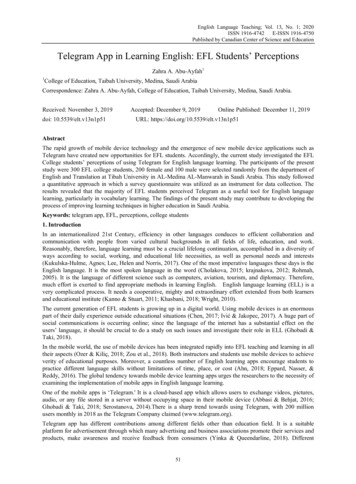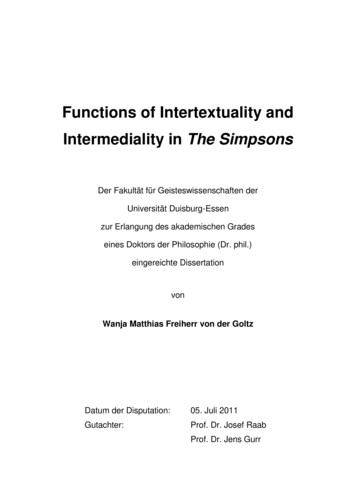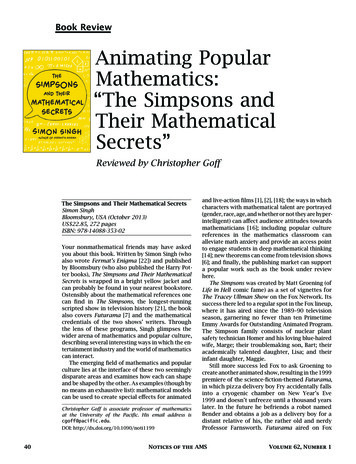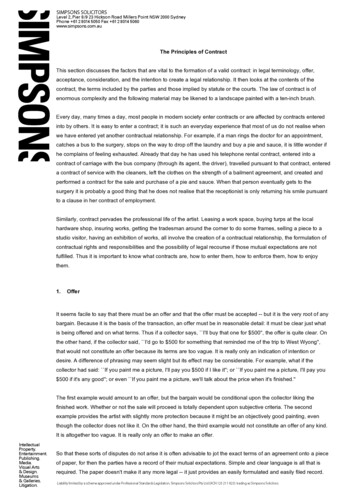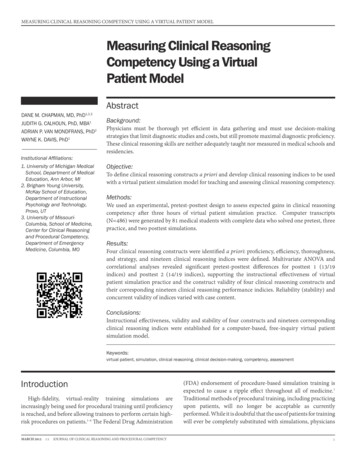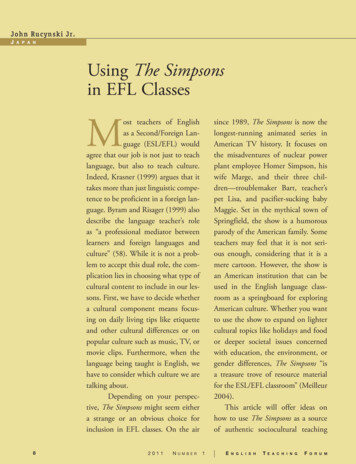
Transcription
Joh n Ru c y n s k i J r.Using The Simpsonsin EFL ClassesMsince 1989, The Simpsons is now thelongest-running animated series inAmerican TV history. It focuses onthe misadventures of nuclear powerplant employee Homer Simpson, hiswife Marge, and their three children—troublemaker Bart, teacher’spet Lisa, and pacifier-sucking babyMaggie. Set in the mythical town ofSpringfield, the show is a humorousparody of the American family. Someteachers may feel that it is not serious enough, considering that it is amere cartoon. However, the show isan American institution that can beused in the English language classroom as a springboard for exploringAmerican culture. Whether you wantto use the show to expand on lightercultural topics like holidays and foodor deeper societal issues concernedwith education, the environment, orgender differences, The Simpsons “isa treasure trove of resource materialfor the ESL/EFL classroom” (Meilleur2004).This article will offer ideas onhow to use The Simpsons as a sourceof authentic sociocultural teachingost teachers of Englishas a Second/Foreign Language (ESL/EFL) wouldagree that our job is not just to teachlanguage, but also to teach culture.Indeed, Krasner (1999) argues that ittakes more than just linguistic competence to be proficient in a foreign language. Byram and Risager (1999) alsodescribe the language teacher’s roleas “a professional mediator betweenlearners and foreign languages andculture” (58). While it is not a problem to accept this dual role, the complication lies in choosing what type ofcultural content to include in our lessons. First, we have to decide whethera cultural component means focusing on daily living tips like etiquetteand other cultural differences or onpopular culture such as music, TV, ormovie clips. Furthermore, when thelanguage being taught is English, wehave to consider which culture we aretalking about.Depending on your perspective, The Simpsons might seem eithera strange or an obvious choice forinclusion in EFL classes. On the air82011Nu m b e r1 En g l i s hTE a c h i n gFo r u m
materials for EFL students and will describehow to use clips of the show to arrange lessonsinto pre-, during-, and post-viewing activitiesto help students learn English and understandimportant elements of American culture andsociety.able to communicate effectively with everyoneelse” (Hirsch 1987, 32). Considering the hugepopularity of the show in the United States,knowledge of The Simpsons is a way for international students to break down barriers andcommunicate with Americans about sharedknowledge. Those who might scoff at theidea of The Simpsons being a part of Americancultural literacy should consider the results ofa recent survey showing that only a quarterof Americans can name more than two of thefundamental freedoms granted by the FirstAmendment, yet more than half can nameat least two members of the Simpsons family (McCormick Tribune Freedom Museum2006). Mark Lieberman, director of the University of Pennsylvania Linguistic Data Consortium, has even claimed that the show has“taken over from Shakespeare and the Bible asour culture’s greatest source of idioms, catchphrases and sundry other textual allusions”(Macintyre 2007). And familiarity with Simpsons characters is not limited to Americans.When doing a survey with her junior highschool class in Norway, one teacher found thatjust as many of her students could identify atleast one Simpsons character as could identifythen President George W. Bush (Kristiansen2001).Introducing cultural content withThe SimpsonsWhen choosing cultural content for ourclasses, we need to consider two basic criteria.First, will the content help students to understand more about the target culture? Second,will the content help students to actually communicate with people from the target culture?Despite being a cartoon, The Simpsonsprovides adequate cultural content and henceeasily satisfies these two criteria. In fact, onewriter even claims that this is the televisionseries that most consistently describes theenvironment of daily American life (Bianculli2000). Additionally, any fan of the show iswell aware that being a cartoon does notequal a lack of seriousness or sophistication.According to University of Virginia professor Paul Cantor, “The Simpsons may seemlike mindless entertainment to many, but infact, it offers some of the most sophisticatedcomedy and satire ever to appear on Americantelevision” (1999, 734). This seriousness refersto the American social issues the show hastackled in its two decades on the air, includingnuclear safety, immigration, gay rights, andsexual harassment. EFL teachers less familiarwith the show should therefore be aware thatThe Simpsons is not a program that you wantto use to teach children. Both the languagelevel and content make it a show appropriateonly for adult students. Again, despite being acartoon, the show is also a great springboardfor serious discussions about American cultureand society.In addition to providing a look at daily lifeand controversial issues in American society,The Simpsons also satisfies the second criteriaof helping English language students to communicate with Americans. When learning aforeign language, students need more thangrammar, vocabulary, and pronunciation;another important skill is cultural literacyregarding the target culture. Popularized byE. D. Hirsch, cultural literacy refers to the“shared knowledge” Americans need “to beEn g l i s hTEa c h i n gFo r u mChallenges of the showDespite the benefits of using The Simpsonsin the classroom, understanding the show isobviously a challenge for non-native speakers.Therefore, I will examine some of these challenges and provide tips for making the showmore accessible to students.Vocabulary and slangAs they might with any TV show or movie,non-native speakers will struggle with theadvanced vocabulary and slang used in TheSimpsons. It is worth repeating that despitebeing a cartoon, The Simpsons is primarilya show for an adult audience, meaning thevocabulary used in the show is not basic. Aspreviously mentioned, the show has tackledmany serious topics, increasing the chancesthat advanced or technical vocabulary will beused. Additionally, the show has been knownto create its own vocabulary and is credited with such additions to the dictionary as“D’oh!” (Homer’s annoyed grunt) and “Meh”(a sigh of indifference). Other common catch- Number120119
phrases popularized by the show, such as“Don’t have a cow” (“Don’t get so upset”) and“Eat my shorts” (“Leave me alone”), are rarelyused outside of The Simpsons context. Whileit may be part of American cultural literacy,such odd slang will present comprehensionproblems for non-native English speakers.on The Simpsons can be sarcastic or evendark, causing confusion as to why Americansconsider such things funny. Finally, the showsometimes uses clever puns or wordplay,which the average English language learnerwould not easily understand.Cultural literacyAlthough cultural literacy was previouslymentioned as a potential benefit of The Simpsons, it can also be an obstacle. Despite thegrowing worldwide familiarity with Americanculture, the sophisticated writing style of TheSimpsons makes for not only very American cultural references, but also generationaland obscure references. For example, whenHomer’s boss, Mr. Burns, answers the phonewith the greeting “Ahoy hoy,” it may soundnonsensical, but it is actually the originaltelephone greeting suggested by AlexanderGraham Bell, the inventor of the telephone.This is a cultural tidbit that would be lost ona majority of Americans, let alone non-nativeEnglish speakers. In another episode, Homer’s intelligence is greatly increased after heremoves a crayon that had been lodged againsthis brain. Lamenting the ignorance of thosearound him, he moans, “I’m a Spalding Grayliving in a Rick Dees world.” It is doubtfulthat even a majority of Americans would getsuch an obscure cultural reference, as it wouldrequire knowing that Gray’s dry monologuesare considered sophisticated humor and beingfamiliar with Dees’ lighter and more simplistic humor, including the 1970s novelty songDisco Duck.Despite the aforementioned challenges ofThe Simpsons, steps can be taken to make theshow accessible for non-native speakers. It isindeed true that the show is a “treasure troveof resource material” (Meilleur 2004), butspecial care needs to be taken to ensure thatstudents can benefit from watching it.Making The Simpsons accessibleAccessible chunksMovies or TV shows in their entirety areobviously too much for the average EFLstudent to handle, so many teachers advocate comprehensible chunks (King 2002).Considering the fast pace and bizarre twistsof The Simpsons, clips of 3–5 minutes arean appropriate length for classroom use. Inaddition to relatively short clips, pre-viewingactivities such as warm-up questions or preteaching of vocabulary are necessary to makethe clips more accessible. Finally, the key wordhere is “accessible.” Despite the great array ofepisodes and topics to choose from, clips haveto be chosen carefully. Clips with too manyobscure cultural references or inside Simpsonsjokes will frustrate your students. A samplelesson based on a short clip will be providedlater in this article to demonstrate how tomake the show accessible.Repeated viewingsFor EFL students, one viewing of authentic video is rarely sufficient. The first viewingis good for grasping what the students canand cannot understand, allowing the teacherto give clues for the second viewing. Several comprehension or true/false questions canhelp the students understand the gist of eachscene. Most Simpsons DVDs have a languagesetting for English captions, so this is also anoption for the final viewing.HumorHumor obviously varies from culture toculture, and The Simpsons is a very Americanbrand of humor. Although there is a lot ofphysical, slapstick comedy, the show is muchmore lauded for its intelligent and sophisticated humor. The result is plenty of laughsfor the average American, but a real challengefor the average non-native English speaker.Humor is very culture based, and—expanding on the issue of cultural literacy—Ziesing(2001) explains that “understanding humorrequires a number of cultural reference points,including history, customs, games, religion,current events, taboos, kinship structures, traditions, and more” (8). Additionally, humor102011NumberVisual reinforcementWatching authentic video materials doesnot have to be relegated to just listeningexercises. It is best to choose scenes thatprovide visual reinforcement for the plot or1 En g l i s hTEa c h i n gFo r u m
main point. Comprehension questions canbe based not only on listening but on visualcues as well. Additionally, talking about whatthey have seen gives students the chance to usetheir English to practice pre-taught vocabulary related to the scene.Not just a focus on humorWhen I started using The Simpsons in myclasses, I made the mistake of putting theemphasis on the humor. Despite the aforementioned cultural differences when it comesto humor, I naively believed that what wasfunny for me would also be funny for my students. However, as one teacher who has usedThe Simpsons in her classes concludes, “thereis nothing so unfunny as explaining humorin detail” (Kristiansen 2001). The point isthat, although The Simpsons is designed tobe funny, humor need not be the focus ofthe lesson. Spending too much time tryingto explain the humor to non-native speakersmight have the opposite effect of leaving yourstudents frustrated at their inability to understand. In addition to the humor, the show hasenough content—cultural or other—to standon its own as a supplement to the curriculum.Thematic teachingDue to the great variety of themes that TheSimpsons has covered in its long run on television, it is a great complement to thematic orcontent-based teaching. Video has many usesin thematic teaching, from introducing thetheme to wrapping up a theme-based unit(Stoller 1992). Showing TV or movie clips ona theme the students have already studied willalso help them navigate unfamiliar vocabulary(Stryker and Leaver 1997). However you wantto exploit The Simpsons, it is an excellent toolto use in thematic teaching, which will help todemonstrate the seriousness of the show andalso make it more accessible for students, asthematically organized materials are easier forstudents to learn (Singer 1990). The followingsuggested thematic topics offer options for theEFL teacher who uses the show in class.Suggested thematic lesson topicsWith more than 400 episodes to choosefrom, The Simpsons offers an almost endlessselection of possible thematic topics. Whichepisodes to use in class will depend on thelevel and focus of your students, but the showEn g l i s hTEa c h i n gFo r u m tends to be at its best when it tackles seriouscurrent social issues. Again, this demonstratesthat the show is more appropriate for adultsthan children. Watching such episodes willhelp students learn more about deeper cultural issues than just, for example, light topicslike American holidays or food. Ideally, it willalso lead to interesting cross-cultural discussions on cultural attitudes toward differentissues. Below are just a few recommendedtopics and episodes. (The season numbers andairdates are written in parentheses.)Sex roles and gender issuesConsidering the sibling rivalry betweenBart and Lisa, and Homer’s lack of chivalry,this topic comes up again and again throughout the series and can be explored in interesting ways. Some of the episodes that illustratethis topic are: Separate Vocations (Season 3, 1992):On a career aptitude test, Bart is suitedto be a police officer while Lisa is chosen as a homemaker, rather than thesaxophone player she dreams to be.This is a good episode for exploringgender roles and standardized testingbias. Marge Gets a Job (Season 4, 1992):Marge gets a job at the power plant butis fired for not going
The Simpsons in EFL Classes M ost teachers of English . as a Second/Foreign Lan-guage (ESL/EFL) would agree that our job is not just to teach language, but also to teach culture. Indeed, Krasner (1999) argues that it takes more than just linguistic compe-tence to be proficient in a foreign lan-guage. Byram and Risager (1999) also describe the language teacher’s role as “a professional .File Size: 206KBPage Count: 10
